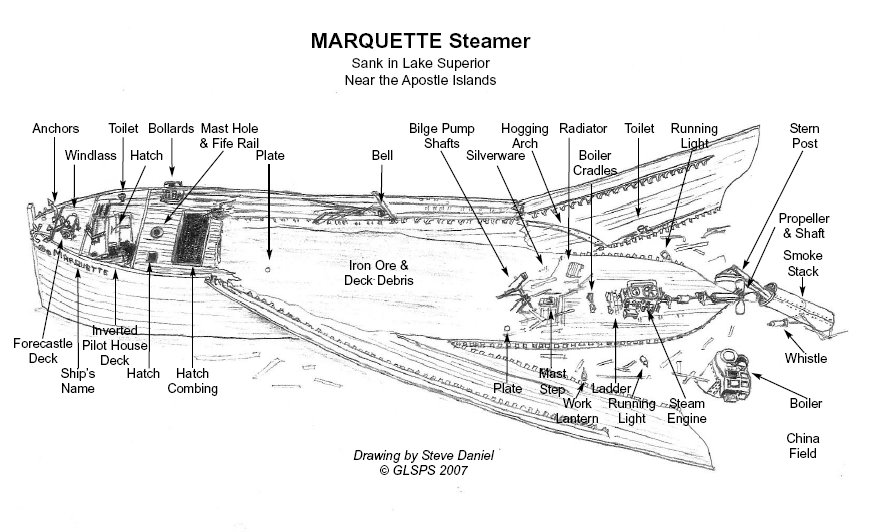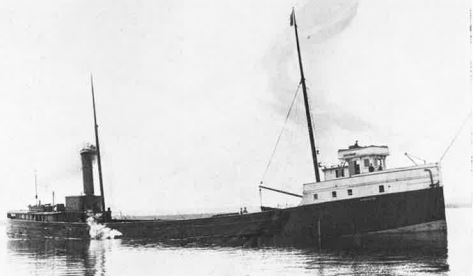Service History
The wooden hull bulk freighter
Marquette was built in 1881 by George Presley & Company at Cleveland, Ohio for the Republic Iron Company and originally named
Republic. The name was changed to
Marquette on August 5, 1890. Her official registry number was 110465. The
Marquette was one of a transitional class of Great Lakes bulk freighters that began to employ innovative hull strengthening technologies to accommodate greater gross tonnage and longer hulls, while preserving stability. Originally, the ship had three masts and she carried the canvas for the masts, but the sails were used more for stability rather than a significant source of power.
1887, winter: May have grounded on Grand Island during the winter.
1890, May: While towing the schooner
Grace Holland on Lake Superior, the
Marquette broke a crank pin and was towed to Cleveland for repairs. This is when the two fore and aft compound engines were replaced by a single fore and aft engine.
This was also the time that the name was changed from
Republic to
Marquette.
Last Document of Enrollment Surrendered: December 18, 1903: Cleveland:"Foundered, Michigan Island, October 15, 1903."
Final Voyage
The
Marquette was lost under mysterious circumstances in October 1903 while hauling a cargo of iron ore out of Ashland, Wisconsin. The Lake was reportedly calm when the steamer began leaking with no obvious cause. Although she foundered rapidly, her entire crew was able to escape. She was one of six vessels to be lost by the owner, J.C. Gilchrist in the 1903 season, prompting speculation that she may have been scuttled for financial reasons. The
Marquette was a total loss, the vessel itself was valued at $65,000 and the cargo $50,000.
"The
Marquette had arrived at Ashhland, Wisconsin, light with no consort to take on a cargo of iron ore. On Wednesday, 14 October at 4:00 PM, she completed loading 1319 tons of ore at the Central Ore Dock and 700 tons of ore at the Northwestern Ore Dock. The
Marquette was loaded near capacity when she departed for Cleveland. She headed out along the shipping lanes and made good time. At around midnight, the crew reported to Captain Caughill that the ship was taking on water from an unknown source. The captain went below deck and found that the water was entering at an alarming rate. He ordered the pumps started and head to Michigan Island, the nearest land, which he judged to be about 25 miles away. As the ship raced for the island, she settled further into the water, slowing her progress with each passing minute. By 2:45 Am, the situation began to look grim. Captain Caughill advised most of the 13 man crew to take to the lifeboats, leaving only himself, the second engineer, the second mate and a watchman to guide the ship to the beach. The ten men who took to the lifeboats began rowing for Michigan Island, some five miles away. On board the
Marquette, the four remaining men readied a lifeboat in case the
Marquette should founder before reaching shore. Scarcely an hour had passed when the vessel began to founder rapidly. the men took the lifeboat and pulled away from the wreck just in time to avoid her suction vortex as she plunged for the bottom." Milwaukee Sentinel, 1903.
Today
In the fall of 2004, the Great Lakes Shipwreck Preservation Society (GLSPS) located the remains of the
Marquette in deep water off of Michigan Island in Lake superior and in 2006 GLSPS members documented the wreckage. The
Marquette lies in 215 feet of water five miles east of Michigan Island, Lake Superior. Michigan Island was the
Marquette's last reported destination in an attempt to beach the foundering vessel, but today the wreckage lies on a heading of 135 degrees, facing south east, away from Michigan Island.
The
Marquette's current condition is evidence of the vessel's rather violent descent. The
Marquette's entire superstructure was torn free during the sinking, and today the vessel's hull is progressively broken from bow to stern. Despite the hull's broken nature, many large hull structures remain intact but are opened up enough to allow examination.


